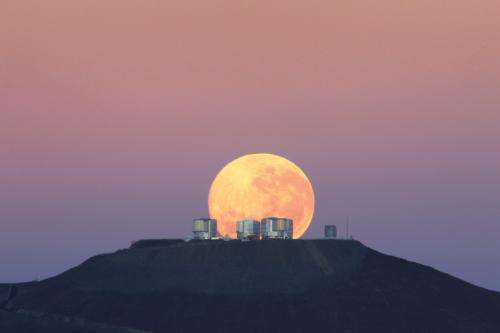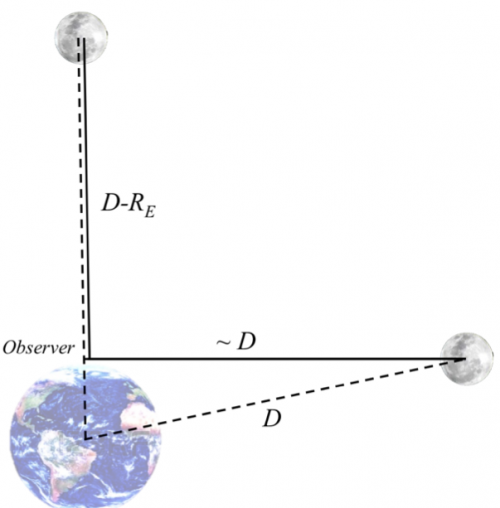The dazzling full moon sets behind the Very Large Telescope in Chile’s Atacama Desert in this photo released June 7, 2010 by the European Southern Observatory. The moon appears larger than normal due to an optical illusion of perspective. Credit: Gordon Gillet, ESO.
Astronomy is a discipline pursued at a distance. And yet, actually measuring that last word—distance—can be incredibly tricky, even if we set our sights as nearby as the Moon.
But now astronomers from the University of Antioquia, Colombia, have devised a clever method that allows citizen scientists to measure the Moon's distance with only their digital camera and smartphone.
"Today a plethora of advanced and accessible technological devices such as smartphones, tablets, digital cameras and precise clocks, is opening a new door to the realm of 'do-it-yourself-science' and from there to the possibility of measuring the local Universe by oneself," writes lead author Jorge Zuluaga in his recently submitted paper.
While ancient astronomers devised clever methods to measure the local Universe, it took nearly two millennia before we finally perfected the distance to the Moon. Now, we can bounce powerful lasers off the mirrors placed on the Lunar surface by the Apollo Astronauts. The amount of time it takes for the laser beam to return to Earth gives an incredibly precise measurement of the Moon's distance, within a few centimeters.
But this modern technique is "far from the realm and technological capacities of amateur astronomers and nonscientist citizens," writes Zuluaga. In order to bring the local Universe into the hands of citizen scientists, Zuluaga and colleagues have devised an easy method to measure the distance to the Moon.
The trick is in observing how the apparent size of the Moon changes with time.
While the Moon might seem larger, and therefore closer, when it's on the horizon than when it's in the sky—it's actually the opposite. The distance from the Moon to any observer on Earth decreases as the Moon rises in the sky. It's more distant when it's on the horizon than when it's at the Zenith. Note: the Moon's distance to the center of the Earth remains approximately constant throughout the night.
As the moon rises its distance to an observer on the surface of the Earth is slightly reduced. Credit: Zuluaga et al.
The direct consequence of this is that the angular size of the moon is larger—by as much as 1.7 percent—when it's at the Zenith than when it's on the horizon. While this change is far too small for our eyes to detect, most modern personal cameras have now reached the resolution capable of capturing the difference.
So with a good camera, a smart phone and a little trig you can measure the distance to the Moon yourself. Here's how:
- Step outside on a clear night when there's a full Moon. Set your camera up on a tripod, pointing at the Moon.
- With every image of the Moon you'll need to know the Moon's approximate elevation. Most smartphones have various apps that allow you to measure the camera's angle based on the tilt of the phone. By aligning the phone with the camera you can measure the elevation of the Moon accurately.
- For every image you'll need to measure the apparent diameter of the Moon in pixels, seeing an increase as the Moon rises higher in the sky.
- Lastly, the Moon's distance can be measured from only two images (of course the more images the better you beat down any error) using this relatively simple equation:
where d(t) is the distance from the Moon to your location on Earth, RE is the radius of the Earth, ht(t) is the elevation of the Moon for your second image, α(t)
is the relative apparent size of the Moon, or the apparent size of the Moon in your second image divided by the initial apparent size of the Moon in your first image and ht,0 is the initial elevation of the Moon for your first image.
So with a few pictures and a little math, you can measure the distance to the Moon.
"Our aim here is not to provide an improved measurement of a well-known astronomical quantity, but rather to demonstrate how the public could be engaged in scientific endeavors and how using simple instrumentation and readily available technological devices such as smartphones and digital cameras, any person can measure the local Universe as ancient astronomers did," writes Zuluaga.
The paper has been submitted to the American Journal of Physics.
More information: "The simplest method to measure the geocentric lunar distance: a case of citizen science." Jorge I. Zuluaga (FACom/IF/UdeA), Juan C. Figueroa (Independent Software Developer), Ignacio Ferrin (FACom/IF/UdeA) arXiv:1405.4580. arxiv.org/abs/1405.4580
Journal information: American Journal of Physics
Source: Universe Today


























